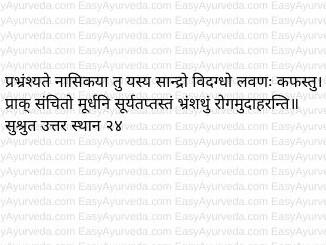Bhramshathu – Meaning, Causes, Symptoms, Treatment
By Dr Raghuram Y.S. MD (Ay) & Dr Manasa, B.A.M.S
Bhramshathu is a similar condition to that of Kshavathu. Both these are nasal disorders. Bhramshathu is explained as a separate entity due to the disease having its own pathogenesis and set of symptoms. Both these conditions have been said to be treated on similar lines. While Master Sushruta has explained this condition, Masters Charaka and Vagbhata haven’t explained the same.
Read – Allergic Rhinitis: Causes, Remedies, Ayurvedic treatment, Herbs
Table of Contents
Pathogenesis and symptoms
When thickened kapha has been burnt , obtained salty taste and has already accumulated in the head and nose gets melted due to the heat of pitta or heat of the Sun, starts getting discharged from the nose. This nasal disease is called as bhramshathu.
This condition resembles the symptom available in many nasal disorders i.e. thickened nasal discharges. It is often associated with chronic inflammation of the nasal mucosa. Since bhramshathu is explained exactly after the explanation of kshavathu nasal disorder and also treatment of both these conditions has been said to be the same we can understand that bhramshathu is closely related to kshavathu. Bhramshathu can thus be considered to be a chronic stage or matured stage of kshavathu or even as a complication of kshavathu.
In the nasal disorders pinasa and pratishyaya – ama and pakva stages have been explained i.e. unripe and ripe stages (acute and chronic stages). Similarly we can assume that kshavathu is the unripe form and bhramshathu is the ripe stage of the same disease.
Read – Chronic Sinusitis: causes, symptoms, Ayurvedic treatment
Sanskrit Verses

Probable modern correlation
In Kshavathu there are thin and dilute secretions with frequent sneezing. This condition has been compared to Vasomotor Rhinitis. Rhinorrhoea is one of the symptoms of Vasomotor Rhinitis. Some authors have even correlated Kshavathu to Vasomotor Rhinorrhea. When rhinorrhea occurs repeatedly or when it is mismanaged, the disease can go deeper. This also leads to thickening of nasal mucosa i.e. hypertrophy. At the same time the infection go deeper into the sinuses if the secretions and mucosa get infected. Subsequently the sinuses might get inflamed and hypertrophied over a period of time. The secretions too are stagnated therein. When the patient gets exposed to the sunlight, the secretions melt and flow out through the nostrils. This condition is similar to the pathogenesis of bhramshathu explained in Ayurveda. Bhramshathu can thus be closely compared to a condition called as ‘mucoid discharges from the hypertrophied lining membranes of the sinuses’.
Read – 4 Remedies For Morning Sneezing With Turmeric, Black Pepper, Tulsi
Treatment of Bhramshathu
The treatment principles, formulations and dietetic inclusions, everything in bhramshathu is said to be done on similar lines of treating kshavathu.
Magadhi Avapidana
The juice of the below mentioned herbs should be squeezed inside the nostrils of the patient
- Pippali – Piper longum
- Seeds of drumstick
- Vidanga – Embelia ribes
- Black pepper
Alternatively these herbs should be ground with water, filtered and the juice instilled in the nostrils of the patient.
Click to Consult Dr Raghuram Y.S. MD (Ayu)








